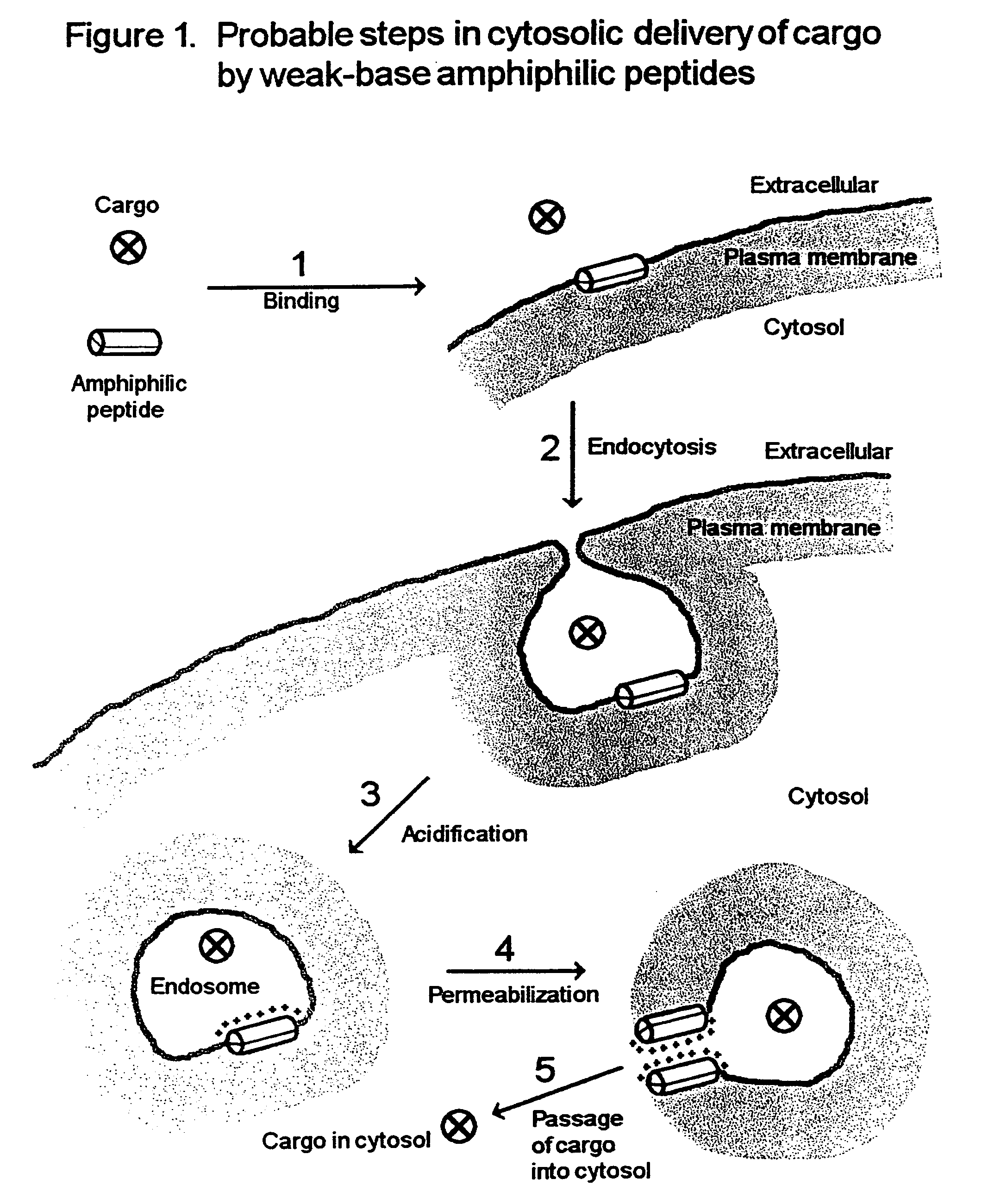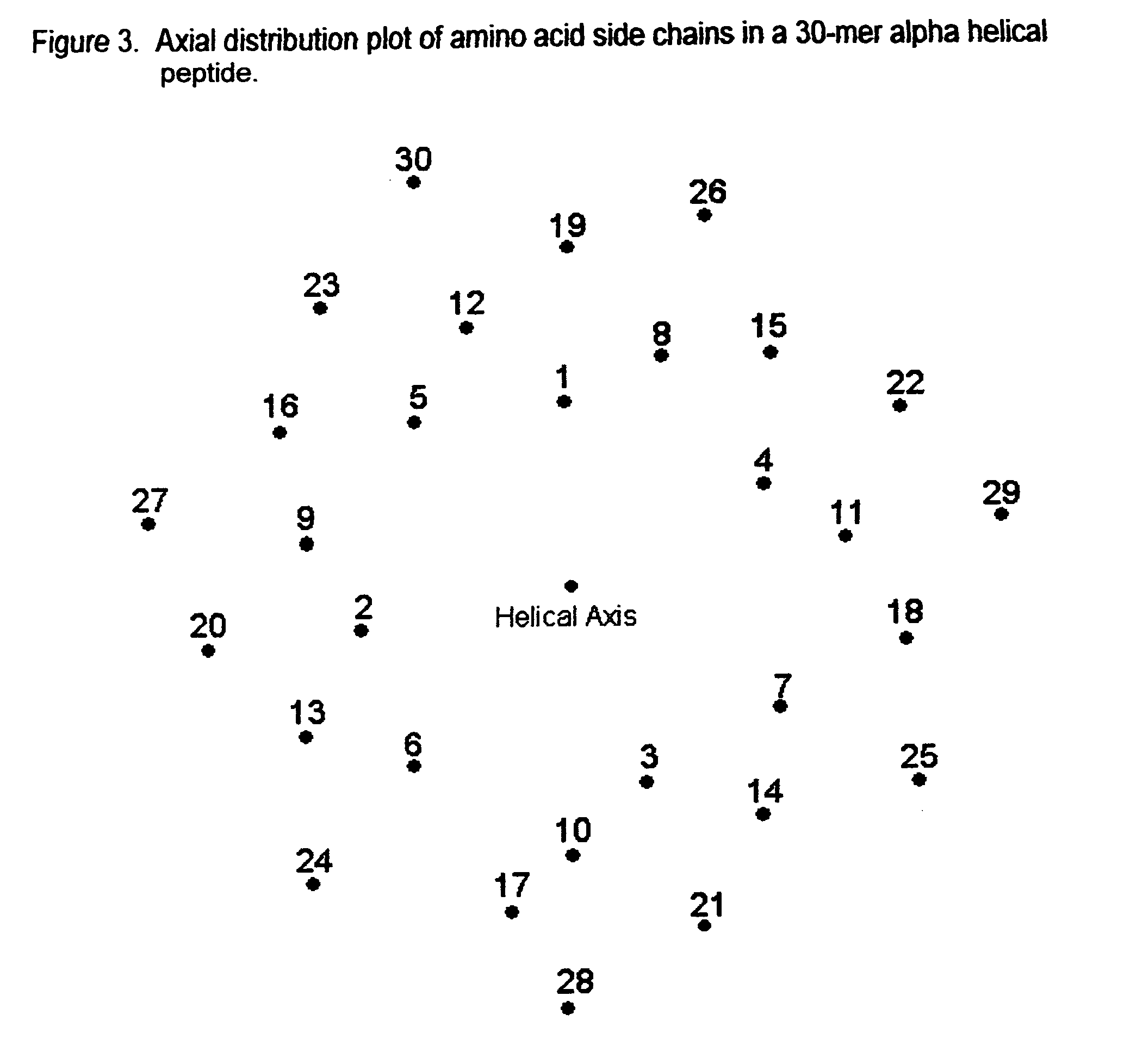Peptide composition and method for delivering substances into the cytosol of cells
a technology of peptides and cytosols, which is applied in the direction of peptides, peptide/protein ingredients, peptide sources, etc., can solve the problems of substantial toxicity to the recipient cells, difficulty in efficiently delivering large polar substances into the cytosol of animal cells without incurring undue damage to those cells, and low efficiency, especially in the presence of even a few percen
- Summary
- Abstract
- Description
- Claims
- Application Information
AI Technical Summary
Benefits of technology
Problems solved by technology
Method used
Image
Examples
example 1
Designing Weak-base Amphiphilic Peptides Using Axial Distribution Plots
[0112]When designing amphiphilic alpha helical peptides where each face is to carry out a distinct function, it is useful to visualize the positioning of the various side chain types, both around the helical axis and along the length of the peptide chain. While this can be accomplished by molecular modeling, such modeling is relatively slow and requires a large investment of resources in order to allow easy comparisons between multiple peptides.
[0113]In contrast, by plotting side chain positions of a peptide on the spiral axial distribution plot illustrated in FIG. 3, one can rapidly and easily visualize and compare the key side chain distributions for large numbers of peptides. This is illustrated in FIG. 13 wherein the semi-natural weak-base delivery peptide of Midoux (in the 1998 specific reference cited supra) is compared to a representative designed-from-scratch weak-base amphiphilic delivery peptide of the ...
example 2
Synthesis and Processing of Delivery Peptides
[0115]Delivery peptides with the standard anionic C-terminus were made on the Wang resin and assembled by an automated peptide synthesizer using fluorenylmethoxycarbonyl-protected / pentafluorophenyl ester-activated amino acids. Deprotection and cleavage from the resin was with triisopropylsilane / water / trifluoroacetic acid by methods well known in the art (NovaBiochem Handbook and Catalog, 2000).
[0116]Synthesis of delivery peptides with the preferred C-terminal amide were made on a hydroxymethyl polystyrene resin (100–200 mesh, 1% x-linked, 0.82 milliMoles / g, Catalog # 01-64-0110 from NovaBiochem). After assembly by an automated peptide synthesizer using fluorenylmethoxycarbonyl-protected / pentafluorophenyl ester-activated amino acids, followed by addition of any desired N-terminal moiety, the resin / peptide preparation was washed well with dichloromethane and then suspended in 2% water / 5% triisopropylsilane / 30% dichloromethane / 63% trifluoroa...
example 3
Covalent Linking of Delivery Peptide to Cargo
[0121]When the delivery peptide is to be linked to the cargo, the preferred linkage type is a disulfide bond. A variety of methods for linking one molecule to another via a disulfide bond are well known in the art, such as described in Bioconjugate Techniques (Hermanson, 1996).
[0122]The following is a procedure for coupling a delivery peptide of the instant invention to a representative cargo comprising a Morpholino antisense oligo. FIG. 14 illustrates key structures and reactions described in this procedure.
a) Preparation of Disulfide Linker Reagent (I)
[0123]Stir 20 milliMoles of 4,4′-dithiodibutyric acid and 50 milliMoles of p-nitrophenol in dichloroethane till disolved. Add 42 milliMoles of 1,3-diisopropylcarbodiimide, cover and let stand at room temp. 3 hr. Filter off solid (diisopropylurea) and purify diester product (I) on silica gel column eluted with dichloromethane. Precipitate product by adding hexane, collect by filtration and ...
PUM
| Property | Measurement | Unit |
|---|---|---|
| pKa | aaaaa | aaaaa |
| weight | aaaaa | aaaaa |
| weight | aaaaa | aaaaa |
Abstract
Description
Claims
Application Information
 Login to View More
Login to View More - R&D
- Intellectual Property
- Life Sciences
- Materials
- Tech Scout
- Unparalleled Data Quality
- Higher Quality Content
- 60% Fewer Hallucinations
Browse by: Latest US Patents, China's latest patents, Technical Efficacy Thesaurus, Application Domain, Technology Topic, Popular Technical Reports.
© 2025 PatSnap. All rights reserved.Legal|Privacy policy|Modern Slavery Act Transparency Statement|Sitemap|About US| Contact US: help@patsnap.com



